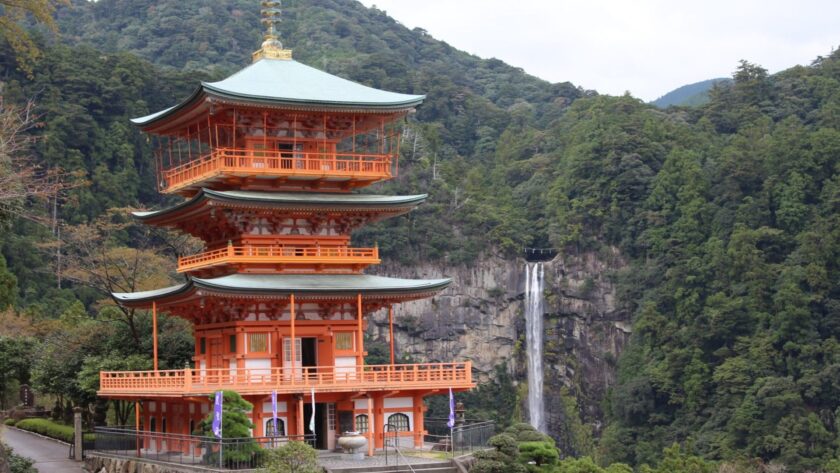
By Kate Robertson
Exploring new places and being physically active are two of my passions (and, of course, eating fabulous food). I know that any trip that combines these passions will be a great one, but I had never done a pilgrimage, so when I recently joined a tour offered by Walk Japan to hike the Nakahechi route of the Kumano Kodo trail, I was excited to see what a journey down such an ancient path would bring.
Following are some highlights from this extraordinary Kumano Kodo trek, with my wonderful guide, Ben, helping to facilitate. I highly recommend you add this to your own bucket list. Here’s why:

Almost everybody has heard of the Camino de Santiago pilgrimage route, but most have never heard of the Kumano Kodo which is the only other pilgrimage route that UNESCO has declared a World Heritage route. The trail is located in the southern part of the Kii Peninsula, just south of Osaka, Japan. It is one of many pilgrimage routes in Japan, and connects three shrines: Hongu-taisha, Hayatama-taisha and Nachi-taisha, collectively called Kumano Sanzan.
The route has been used for more than 1000 years, with pilgrimages to shrines becoming popular for the imperial families and aristocracy between the 9th and 12th centuries. During this time, Kumano was worshipped as a place of rebirth where spirits going to the afterworld would gather and pray for their happiness in the next world. By the 14th century, samurai warriors and commoners started to do the pilgrimage, and by the 17th century it had widely spread to all. Posthumous remains of various deities are still held at each of the shrines.
The pilgrimage route is becoming increasingly popular, and along the way there are traditional accommodations in isolated villages making multi-day walks like we did possible. Some portions of the trail have been paved with cobblestones to prevent erosion from heavy rains, as it weaves through a variety of mountain passes, quaint villages, bamboo groves, mossy Japanese cypress forests and terraced rice fields.
Interestingly, the trail has embodied a unique mix of both Shinto and Buddhism religions. I couldn’t wait to begin.

A Spiritual Start In Koyasan
Our 9-day tour started with a 7.5 kilometer (4.6-mile) day-long hike which skirts the perimeter of the town of Koyasan on what was once a pilgrimage route for women only. Present day Koyasan is an active monastic center, established 12 centuries ago by the renowned monk, Priest Kukai, who was the founder of Esoteric Buddhism. It is still the headquarters of the Koyasan sect of Shingon Buddhism which is practiced widely throughout Japan, and it has a university dedicated to religious studies.
The ascetic training ground of Koyasan was prohibited to women until 1872, so temples where they could worship and seek lodging outside the perimeter were built at various entrances. There are breathtaking vantage points — like the one that we stopped at above — along the trail where the women could catch glimpses of the holy shrine. Walking this trail in my comfortable hiking pants and trail runners, I couldn’t help but wonder what it must have been like to hike this trail 1000 years ago wearing a traditional kimono and stacked sandals.
#Hiking in sneakers, I wondered what it was like 1000 yrs ago in a kimono & stacked sandals. #japan Click To Tweet
Getting Relief In Okuno-in
In Koyasan you will also find Okuno-in (the inner sanctuary), the largest cemetery in Japan with over 200,000 tombstones lining the two-kilometer- (1.2-mile-) long approach to the previously mentioned Priest Kukai’s mausoleum. Here he is believed to be in eternal meditation while he awaits the Buddha of the future. In the meantime, he provides relief to those who ask for salvation.
Many famous monks, feudal lords and emperors have headstones here, as well as modern day corporations. There is even a special monument erected by a pesticide company to pray for all of its insect victims.

Before entering the mausoleum grounds you can make a stop to pray for departed family members at the row of statues known as mizumuke Jizo (water covered Jizo, one of the most beloved of all Japanese deities who works to ease the suffering and answer prayers). The grounds are breathtakingly lit with thousands of lanterns said to have been burning constantly since Kukai’s death, and I recommend touring the cemetery at dusk to get the full effect of the lanterns. I could almost hear the whispers of the shoguns, samurais and emperors, and unlike some cemeteries it didn’t feel spooky, but rather, peaceful and calm.
A pesticide company even erected a monument to pray for all its insect victims. #japan Click To Tweet

A Shukubo Temple Accommodation
There are over 100 temples in Koyasan, and we stayed in one of the many which offer accommodation for pilgrims and tourists. I set my alarm for 5:30am — this was a pilgrimage, after all — and joined the sutra chanting and goma fire ritual at dawn, where we were invited to write a wish on a wooden stick called a goma-gi. The monks then burned them to represent Buddha burning away the root of our suffering.

Like all traditional Japanese accommodations, at shukubos (temple accommodations) there is an onsen, or public hot springs bath meant for socializing and enjoying the mineral waters’ healing powers. Here I had to let all sense of modesty drop, a difficult but freeing experience, as you don’t wear a bathing suit in Japanese baths. Luckily, male and female baths are separate.
Dining is shojin-ryori, traditional vegetarian meals, made with simple ingredients like goma-dofu (sesame tofu), seasonal wild mountain edible plants and sweet and sour seaweed, as well as familiar favorites like miso soup, tempura veggies and, of course, rice. It is considered polite to finish every grain of rice to show respect, as the Japanese way of growing rice is time-consuming and laborious. There are also other points of etiquette I learned, like not to pour soy sauce directly on my rice and not to leave chopsticks standing in the bowl, as this is only done at funerals.
I was not to leave chopsticks standing in my bowl, as this is only done at funerals. #japan Click To Tweet

On The Kumano Kodo Nakahechi Trail
A major goal of the Kumano pilgrimage is to rid one’s body and spirit of impurities from past and present lives, and to be ritually reborn and rejuvenated by the virtuous powers of the Kumano deities. Purification rituals were practiced — and still are — fervently along the way, elevating a pilgrim’s purity at each site along the way. As part of my personal pilgrimage, I embraced this cleansing ritual which Ben showed us how to perform by washing each of our hands and rinsing our mouths, being careful, or course, to not spit back into the clean water.

On the way to Hongu-taisha Shinto shrine is the Hashiori-toge Pass, where I first start to realize I will have well-defined calves at the end of this hike. At the top of the pass you will see the statue known as gyuba-doji which depicts Kazan (968-1008), one of the first emperors to pilgrimage to Kumano, as a boy, riding a horse and a cow at the same time. This stone image was made in the Meiji Era (around 1891) in remembrance of Kazan’s journey and has become a symbol of the Nakahechi Trail.

Reaching The Hongu-taisha Grand Shrine
A two and a half day hike from the Taka-jiri entrance, a popular starting point for the Nakahechi, takes us to the first of the Kumano Sanzan shrines, Hongu-Taisha. Hongu-taisha is the head shrine of more than 3,000 Kumano shrines located through Japan. It has a dramatic entrance up a long path of 158 stone stairs, where you arrive at four shrines in a row constructed with traditional cypress bark roofs. There is also a museum here where I learn the astounding fact that the centuries-old construction techniques like building the impressive curved roofs covered with foot thick bark are passed down the generations as the parts of the shrine are regularly updated.

Hongu-taisha was originally located a short distance away at Oyunohara, but a severe flood in 1889 destroyed it. The salvaged remains were rebuilt at the current site. The entrance to Oyunohara is still marked by the largest Torii (shrine gate) in the world and stands at 34 meters (112 feet) tall and 42 meters (138 feet) wide, a gateway that signifies the division of the secular and spiritual worlds.
The walk up to this gate, through rice paddies, was one of the most awe-inspiring scenes on the route.

Wishes & Waterfalls En Route To Nachi-taisha
Continuing on route to Nachi-taisha shrine we pass waroda-ishi (round-shaped cushion rock), where the Kumano deities are believed to meet and chat over tea. The three carved symbols are bonji Sanskrit characters assigned to buddhas and bodhisattvas. This is an example of where Shinto-Buddhism philosophy has done a stellar job of mixing the two religions and professes Shinto deities are manifestations of the Buddhist figures. The coating of moss was so thick in places it looked like you could sleep on it.

The next two-days of hiking are through the most difficult and steepest section of the trail, via two mountain passes, the toughest being ogumotori-goe which means “passing over clouds,” and the highest point on the Nakahechi. Ex-emperors lamented over the steepness here in their travel diaries, and I can certainly see why.
But the grueling uphill is worth it, when on the other side of the pass we drop down to the Nachi-taisha shrine, which is the most visually spectacular with its colorful vermilion gates and shrines, located halfway up Nachi mountain.
I could not help but feel the mystical energy here. Unlike the other shrines, it is in a remote location, so it was easy to imagine what it was like centuries ago.
Many pilgrims choose the dramatic daimonzaka entrance, a tree-lined uphill trail that takes you to the steep shrine steps. Here it is said if you walk through the hollow root of the camphor tree holding goma-gi (the wood to offer the god with your wish written on it), your wish will come true.
When we walk another 15 minutes we see Nachino-taki waterfall in the background, the largest waterfall in Japan and the initial object of worship. In Shinto tradition, shrines were largely built around natural beauty, like large rocks and waterfalls.
Emperors lamented over the steepness in their #travel diaries. I can see why. #japan Click To Tweet
High Hopes At Hayatama-taisha
This taisha, or shrine, is located on the southeast coast of the Kii Peninsula, and the last of the three major shrines. The buildings here were recently rebuilt, but the shrine has been located on the same spot on the Kumano riverbank since the 12th century.
Here you will still find an 800-year old naginoki tree (broadleaf podocarpus) as well as gotobiki-iwa, a gigantic rock that was revered as a deity, located halfway up the mountain and reached by climbing a steep set of 538 rock-hewn steps — aka an added calf workout — painstakingly built by assembling natural stones. The rock has the Kamakura shrine at its base which is believed to be the first shrine the god of Kumano descended to. Ritualistic objects from as early as the 3rd century have been found underneath.
For 1400 years, each February brings a festival called Oto Matsuri, where 2,000 men dressed in white and tied together with thick rope ascend the stairs to light a torch from a sacred fire. Afterward, they race down the steps — in the dark — until they burst through the shrine gates below. The smoke from the torches signifies hopes and wishes being carried up to heaven. The shrine itself is closed to women for this day, but for me, a trip just to see this festival would be well worth it to watch people running down these steeply-angled steps in the dark.
Learning so much on this journey about the culture and history of Japan, so different from the West, was impactful. But the real highlight in the end was the spiritual journey and reflection upon my own life that was prompted by retracing the footsteps of the millions of people before me who had made this journey for their own moral and spiritual reasons.
As Ernest Hemingway said: “It is good to have an end to journey toward, but it is the journey that matters, in the end.” The journey continues…
The smoke from the torches signifies hopes and #wishes being carried up to #heaven. #japan Click To TweetTrip Details
This 9-day hiking tour costs Y362,000 or approximately $3,000.00. Click here for more information. Walk Japan also offers self-guided tours; however, based on my experience I would recommend one of the guided ones. You can learn so much more when you have someone like Ben, our guide, who was full of historical tidbits and cultural anecdotes about everything along the trail. Walk Japan offers many different walking tours, and specialty tours such as photography or golf tours. Peak seasons are spring, to view the pastel pink sakura (cherry blossoms) and fall, when you will see the beautiful red colors of the momiji (Japanese maple).

About Kate Robertson
Kate Robertson is a Canadian freelance writer, and a regular contributor to a variety of magazines. She is a member of the British Columbia Travel Writers Association and Travel Media Association of Canada. Kate has a passion for active solo travel, and her writing interests include active/adventure travel, culture, food & drink, spas, health & wellness, responsible tourism, and epic/off the beaten path adventures. Find Kate on Twitter @kateflyingsolo.
Kate Robertson
Latest posts by Kate Robertson (see all)
- How To Indulge In Turkey’s Delicious Culinary Culture - Jan 11, 2018
- How To Have A Sustainable (And Fun!) Trip In Charlottetown, Canada - Oct 9, 2017
- How To Help The Planet By Drinking Icewine - May 24, 2017
- How To Explore Phoenix’s Sustainable Food Culture - Apr 17, 2017
- Why Cape Breton Island Has the Most Delicious Lobster In The World - Jan 9, 2017






Nice post. Thanks for sharing your post.
This is very informative and nice post. Thanks for sharing your post.
Amazing post. Keep it up. Thanks a lot.